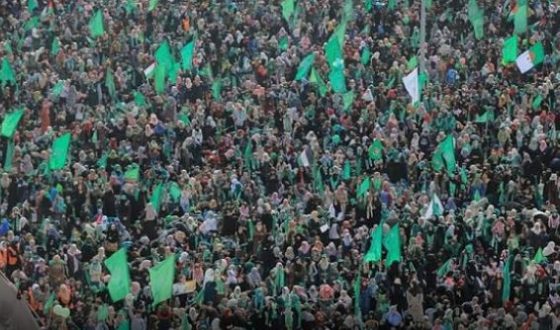BESA Center Perspectives Paper No. 1,092, February 20, 2019
EXECUTIVE SUMMARY: The photos and particularly the videos of Hamas’s 31st anniversary commemoration in Katiba Square in Gaza evoke the impression of a vibrant, extremely popular movement after 11 years of rule over Gaza. This impression is patently false.
Hamas did its best to create the impression that enormous, enthusiastic crowds attended its recent 31st anniversary commemoration in Katiba Square in Gaza. Its object was to stoke the image of a vibrant movement that remains extremely popular after 11 years of rule over Gaza.
No doubt, the event was impressive, not least because the Israeli air force knocked out the al-Aqsa broadcasting site in November during the largest flare-up since the 2014 confrontation. Hamas proved that it could broadcast live despite the site’s destruction, and the event itself showed no small measure of organizational efficiency.
Women and men were separated by a cordon of Hamas officials in military dress and yellow vests. Green flags were plentiful and the deep podium was impressively adorned. The speeches and the skits, one of which featured an Israeli soldier cowering before his guards, were well orchestrated. In short, the event proceeded like clockwork.
Yet it taught us very little about Hamas’s popularity. The events in Tahrir Square in Cairo are an instructive memory in this regard. The massive crowds that assembled there before and during Morsi’s reign seemed to reflect the popular will and to indicate that the protestors had defeated the Egyptian military and the “deep state” supporting it (the legal, economic, and clerical bureaucracies that have run Egypt since 1952).
Yet the decisive military comeback reflected by Sisi’s assumption of the presidency and the imprisonment of Morsi demonstrated the danger of drawing political conclusions from crowds in squares.
The problem boils down to simple arithmetic. Tahrir Square can hold a maximum of 350,000 people (I calculated this with the help of Google Maps). Even overflowing into nearby streets, the crowd never exceeded half a million – approximately 1% of the adult population of Egypt. In retrospect, most of those 99% who didn’t demonstrate failed to support “the revolution” over the longer term. The proof is that during the showdown, the Muslim Brotherhood could not mobilize large numbers to oppose the military counter-revolution.
The same can be said regarding Hamas.
To begin with, Hamas refrained from holding its commemoration in Gaza’s largest square – the Square of the Unknown Soldier. Instead, it chose the smaller “Sahat al-Katiba al-Khudara,” a square near the Islamic University, a Hamas stronghold. It has a square meterage of 21,000 compared to over 60,000 for the former.
Specialists in traffic flow (usually engineers by training) identify a two person per square meter measurement as the high end of crowd safety. A density exceeding that can only be achieved by professional troops in military formation.
Photos of the commemoration event clearly indicate that the number of participants cannot have exceeded 42,000, or less than 3% of Gaza’s adult population. (Note also that the deep podium considerably reduces the square meterage left for the demonstrators.) This figure explains why Hamas chose the smaller square.
The shadow (and real) Hamas government has on its payroll 51,000 military and civilian employees, many of whom are beneficiaries of the $30 million in cash distributed in Gaza by Qatar. They were bound to show up at the commemoration, as they have been waiting since the spring to receive half their salaries. Hamas has not paid full salaries since early 2014, when Sisi closed down most of the smuggling tunnels.
There are of course far needier Gazans than Hamas employees; but Qatar’s financial support for Hamas has more to do with the organization’s bitter feud with the Palestinian Authority (and more broadly – with Qatar’s own feud with Saudi Arabia and the UAE) than with the desire to provide humanitarian support.
The crucial question is whether Hamas will privilege meeting the needs of its bureaucracy and thus allow itself to be “tamed” to keep the peace, or stick to the path of aggression it renewed in April 2018 with the “March of Return” processions.
The answer probably lies somewhere in the middle, between Qatar, which wants a tamer but independent Hamas, and Iran, which wants bloodshed on Israel’s southern front. The problem for Hamas is that it needs money from both.
This is an edited version of an article that appeared in The Jerusalem Post on February 2, 2019.
Prof. Hillel Frisch is a professor of political studies and Middle East studies at Bar-Ilan University and a senior research associate at the Begin-Sadat Center for Strategic Studies.


